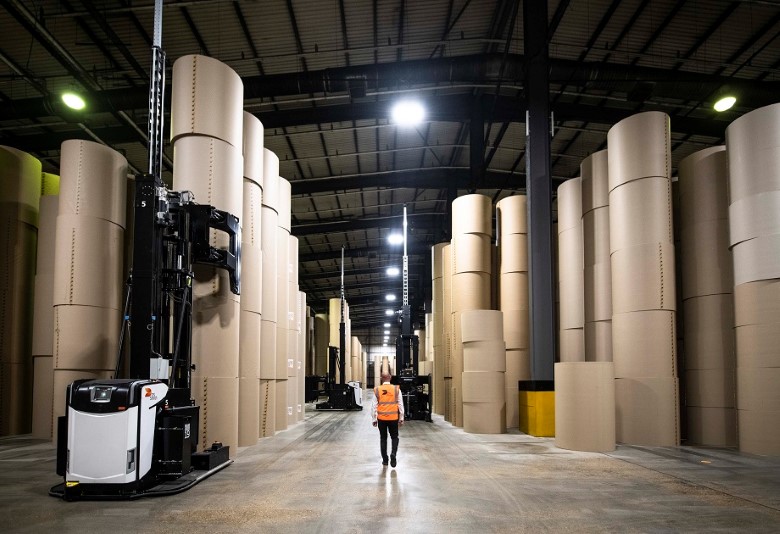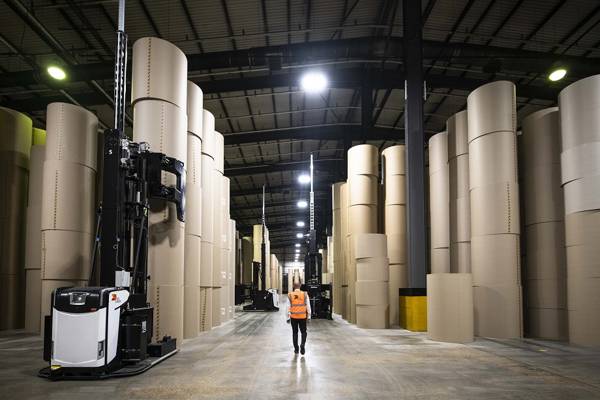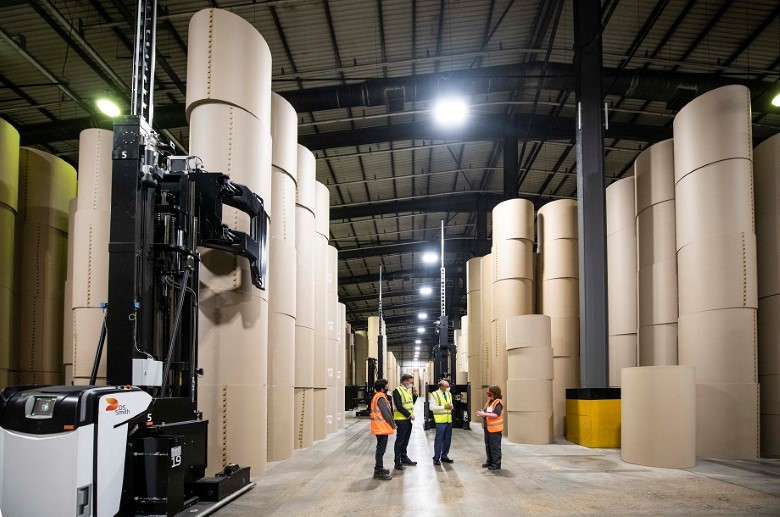Robots at work: Investing in technology to increase sustainability
We’re constantly innovating to provide the best paper products and service for our customers. That’s why we’ve invested in 10 Automated Guided Vehicles (AGVs) to operate at our Kemsley Paper Mill, bringing major benefits for our people, customers and the environment.
Kemsley mill is no stranger to innovation
Kemsley has a long history of adopting the latest technology. When it was originally built in 1924 its four paper machines were the largest in the world. Today the mill is the UK’s biggest recovered fibre-based paper operation and the 2nd largest in Europe with an annual production capacity of over 840,000 tonnes.

How do you move thousands of tonnes of paper quickly, safely and sustainably?
Every day around 2,400 tonnes of paper leaves Kemsley mill for our customers. That’s the equivalent weight of 457 fully grown male elephants.
So with the mill operating around the clock, 363 days a year, how do we manage this constant volume of paper reels moving from our machines to our warehouse ready for despatch?
Enter a team of our skilled people, assisted by our new AGVs.
Supplied by AGV pioneer Rocla, these intelligent, all-electric vehicles perform a variety of tasks around our now fully automated warehouse. This includes collecting reels from the production conveyor, storing the reels, and picking them for orders. The team at Kemsley have been upskilled to programme and maintain our new robot workforce and when the AGVs aren’t tasked with work, they automatically switch to housekeeping mode, rotating stocks in order of age and consolidating stocks to maximise our warehouse capacity.
Five benefits to using new robotic technology
1. Robots don’t make mistakes
According to a GE digital survey1, human error is the biggest cause of unplanned downtime in manufacturing. AGVs operate 24/7 within strict rules that ensure constant performance time after time without incident. So our customers’ orders can always be met reliably.
2. Improved loading times
The recent boom in E-commerce has increased the demand for our papers and packaging. Our AGVs can transport our paper reels safely around our warehouse at up to 8 mph, with more precise stock handling, less damage to reels and improved loading times. So we can get paper to our customers sooner.
3. Reduced energy consumption
Our AGVs operate with zero local emissions within the warehouse and will enable us to operate efficiently with overall energy savings for decades. When an AGV detects a battery at 30%, it completes the current task and takes itself to the Automated Battery Exchange Station where it chooses the optimum charged battery, ready for another 10-hour shift.
4. Zero accidents
The safety of our people is key and our long-term target is zero accidents at all our sites. Our AGVs improve workplace safety because unlike traditional forklifts they don’t require operating personnel, have monitored top speeds and can be fully equipped with sensors, alarms, lasers, or cameras to ensure zero harm.
5. More sustainable
The average lifespan of a forklift is 5 years of 24/7 operation. Our AGVs are expected to be in service for up to 12 years. Another example of our how we are meeting the targets in our Now & Next Sustainability Strategy, and building the circular economy by keeping resources and materials in use longer.
We’re investing in people and technology to embrace Industry 4.0

Manufacturing has always adapted and evolved but the papermaking industry isn’t famous for change. It’s often held back by the scale and capital investment needed to adopt new technology, so progress has come slowly and incrementally.
We’re bucking the trend. By investing in AGVs, and training our people to work alongside them, we’re embracing Industry 4.0 – the fourth industrial revolution. Focused on digitalisation, Industry 4.0 will further boost our use of digital technology with smart and autonomous systems, fuelled by data and machine learning.
1 After The Fall: Cost, Causes and Consequences of Unplanned Downtime

